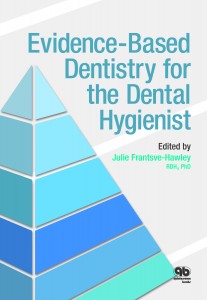For more than 60 years, Quintessence Publishing has been providing cutting-edge scientific and clinical information for dental practitioners, researchers, and students. Yet over the years, more and more dental hygienists have been asking for clinical manuals and textbooks specifically for their field. With Evidence-Based Dentistry for the Dental Hygienist, Julie Frantsve-Hawley and Quintessence answer the call of dental hygienists and provide them with a book written specifically for them and the types of patient situations they face.
Dental hygienists regularly practice scaling and root planing, caries prevention, and patient education. As the first line of contact for the patient, they must be equipped to answer patients’ questions, yet how are they to keep up with the overwhelming amount of evidence published regarding caries and other dental concerns? Julie Frantsve-Hawley, RDH, PhD, has asked that same question and spearheaded an effort to provide a resource for these dental professionals. As Senior Director of the Center for Evidence-Based Dentistry at the American Dental Association, she says, “With current changes in health care and the increasing volume of scientific literature published annually, it is increasingly important, yet also increasingly challenging, for health care providers to maintain current scientific knowledge pertaining to their area of specialty. This is particularly true for dentistry and specifically for dental hygienists.”
This book is intended as a textbook for dental hygienists to learn the importance of evidence-based dentistry (EBD) in the practice of dental hygiene as well as how to implement EBD practices and share EBD findings among office staff. As the dental knowledge base evolves and scientific discoveries are made, dental hygienists must understand how to seek out and evaluate findings and, if appropriate, apply them in their clinical practice, and this book provides all the necessary tools to do just that.
The book is divided into two main parts. The first section addresses the specific skills needed to implement an evidence-based approach into practice. The second section addresses current evidence on topics of interest to the dental hygienist like dental hygiene, dental public health, caries preventive strategies, community water fluoridation, periodontal diseases, screening for cancers of the oral cavity and pharynx, as well as antiresorptive agent–induced osteonecrosis. It is an exceptional resource that will help dental hygienists build a foundational knowledge base in order to effectively and quickly implement EBD throughout their career.

